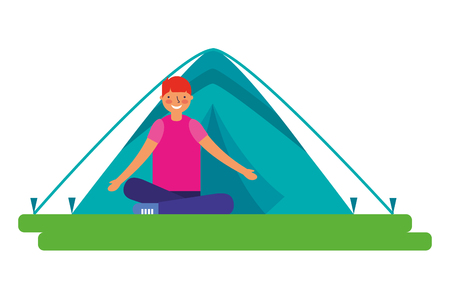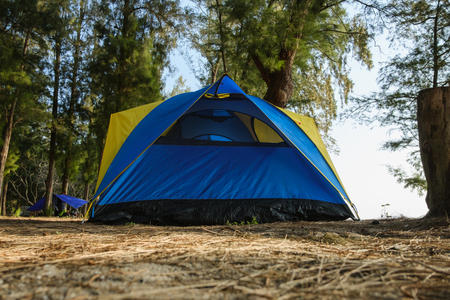Choosing the Right Campsite
When it comes to pitching a tent in high winds, your first and most crucial step is choosing the right campsite. A well-chosen spot can make all the difference between a comfortable night under the stars and a stressful struggle with your tent. Here are some practical tips to help you find a sheltered location, keep wind direction in mind, and steer clear of common hazards often found at American campgrounds.
Tips for Finding a Sheltered Spot
Look for natural windbreaks such as thick clusters of trees, large boulders, or even gently rolling hills. These features can block or redirect strong gusts, providing much-needed protection for your tent. If you’re camping near the coast or in open plains where shelter is limited, consider setting up next to low brush or in the lee of a hill rather than out in the open.
Consider Wind Direction
Before you start unpacking, take a moment to observe which way the wind is blowing. In many parts of the U.S., prevailing winds come from the west, but local geography can create different patterns. Set your tent so its narrowest side faces into the wind to reduce resistance and minimize flapping. This small adjustment can help prevent damage and make your tent more stable during gusty conditions.
Avoiding Common Hazards
Stay clear of spots under dead tree limbs (widowmakers), close to water edges that could rise unexpectedly, or exposed ridgelines where wind speeds are highest. Also, be cautious about setting up too close to campfire pits or picnic areas where flying debris could become hazardous. By taking these precautions, you’ll set yourself up for a safer, more enjoyable camping experience even when Mother Nature turns up the breeze.
2. Essential Gear for Windy Conditions
When camping in high winds, having the right gear is just as important as your pitching technique. U.S. weather can be unpredictable, especially in open plains or mountainous regions, so it’s wise to invest in equipment that can handle sudden gusts and turbulent conditions. Here’s an overview of must-have gear to keep your tent secure and your family safe during those blustery nights.
Heavy-Duty Stakes
Standard stakes often aren’t enough when the wind picks up. Opt for heavy-duty stakes made from sturdy materials like steel or titanium. These stakes are designed to anchor your tent deeply into a variety of ground types, from rocky soil to sandy beaches commonly found across the United States.
| Stake Type | Best For | U.S. Region Examples |
|---|---|---|
| Steel Y-Stakes | Rocky, hard-packed soil | Sierra Nevada, Rocky Mountains |
| Titanium Nail Stakes | Compact or frozen ground | Northern Midwest, New England winters |
| Sand/Snow Stakes | Loose sand or snow | Florida beaches, Colorado slopes |
Guylines and Tensioners
Extra guylines add stability by distributing wind force more evenly across your tent. Look for reflective guylines—they’re easier to spot at night and help prevent tripping hazards around your campsite. Adjustable tensioners let you fine-tune the tautness as wind conditions change, which is particularly helpful during unpredictable U.S. storms.
Reinforced Tent Materials
A tent with reinforced seams and ripstop fabrics is less likely to tear under pressure. Double-check that your rainfly and main body are rated for high winds—some brands even offer models specifically tested for gusts common in American national parks. If you’re planning trips across varied climates, consider tents with interchangeable components to suit both hot desert winds and cold mountain breezes.
Packing Checklist for Windy Campsites:
- Heavy-duty stakes (appropriate for terrain)
- Extra guylines (with reflective strips)
- Tensioners for easy adjustment
- Reinforced tent with strong poles and durable fabric
- Mallet or hammer for driving stakes deep into tough ground
- Duct tape or repair kit for quick fixes on-site
Pro Tip:
If you’re camping with kids, involve them in setting up these essentials—it’s a great learning experience about safety and teamwork, and it helps everyone feel more secure when those strong winds start blowing.

3. Step-by-Step Tent Setup for Stability
Pitching your tent in high winds can be challenging, but with a practical approach and a few advanced techniques, you can ensure your family stays safe and comfortable through the night. Here’s a step-by-step guide to help you set up your tent for maximum stability, even when Mother Nature isn’t cooperating.
Choose the Right Spot
Before you unpack anything, take a moment to study the landscape. Look for natural windbreaks like trees, bushes, or even large rocks. Avoid exposed hilltops and low-lying areas where water might pool if it rains. Think about how the local terrain can give you an edge against strong gusts.
Face Your Tent Head-On into the Wind
It may feel counterintuitive, but pitching your tent so the narrowest end faces directly into the wind reduces resistance and helps keep your structure upright. Most tents are designed with this in mind—check your tent’s instructions for any specific recommendations.
Secure Every Corner from the Start
Lay out your tent flat on the ground and immediately stake down each corner before adding poles. Use heavy-duty stakes (preferably metal) and drive them into the ground at a 45-degree angle facing away from the tent. This keeps the base steady as you build up the structure.
Assemble Poles and Attach Guy Lines Early
Once corners are staked, insert the poles and raise the tent quickly but carefully. As soon as it stands, secure all guy lines—even if they seem unnecessary in light breezes. Tie them out at different angles and use rocks or logs for extra anchoring if soil is loose or sandy.
Double-Check Everything
Walk around your tent and tug gently on stakes and guy lines to make sure nothing will slip if a sudden gust comes through. Adjust tension as needed, using local features to shield vulnerable sides whenever possible. This extra attention to detail ensures you and your loved ones can enjoy your camping adventure without worry—even when the winds pick up.
4. Advanced Anchoring and Guyline Techniques
When you’re camping in high winds, simply staking your tent isn’t always enough. For families who want extra security (and a good night’s sleep!), mastering advanced anchoring methods is key. Let’s explore some tried-and-true strategies that American campers use to keep their tents stable in rough weather.
Double Staking for Extra Security
One of the most effective ways to anchor your tent in high winds is double staking. This technique uses two stakes at each guy point instead of one. Here’s how it works:
| Step | Description |
|---|---|
| 1. Insert First Stake | Drive the first stake into the ground at a 45-degree angle away from the tent. |
| 2. Add Second Stake | Place a second stake about 6 inches behind the first, parallel to it, and connect them with a strong loop of cord. |
| 3. Attach Guylines | Tie your guyline to both stakes using a taut-line hitch or trucker’s hitch for adjustability. |
This method helps distribute wind force across two points, making it much harder for gusts to pull out your stakes.
Using Natural Windbreaks
Sometimes Mother Nature lends a hand! Positioning your tent near natural barriers can make a world of difference:
- Trees: Set up on the leeward side (the side away from the wind) of sturdy trees for protection.
- Boulders: Large rocks can block direct wind blasts. Just make sure they’re stable and not at risk of rolling.
- Bushes or Shrubs: Low vegetation can help diffuse wind around your tent, reducing its impact.
Avoid pitching too close to dead trees or loose rocks for safety reasons—always choose solid, healthy features!
American-Style Guyline Knots for Stability
The right knots can make all the difference when tying down your tent. Here are some popular American-style knots used by experienced campers:
| Knot Name | Main Use | Why It Works |
|---|---|---|
| Taut-Line Hitch | Adjustable tension on guylines | Lets you easily tighten or loosen lines as needed without untying the knot. |
| Trucker’s Hitch | Maximum tension for stability | Adds mechanical advantage, letting you get lines super tight to withstand strong gusts. |
| Bowline Knot | Secure loop at line’s end | Makes a reliable, easy-to-untie loop that won’t slip under pressure. |
If you’re camping with kids, teaching them these simple knots can be a fun hands-on learning activity—and it’ll help everyone feel more confident in windy conditions!
5. Family-Safe Tips and Emergency Prep
Camping in high winds can be an adventure, but keeping your loved ones safe should always come first. Here’s how to make sure your kids, pets, and gear stay secure and everyone enjoys the great outdoors—even when the weather gets wild.
Keep Kids Calm and Informed
Before the winds pick up, talk to your kids about what to expect. Explain that strong gusts can happen and it’s important to stay close to the tent or a safe spot. Set clear boundaries—like no running off—and make a game of “tent check-ins” every hour. A small whistle attached to each child’s jacket is a great backup if you get separated.
Pet Safety First
Pets can get anxious during windy conditions. Make sure leashes are secure and bring their favorite blanket or toy for comfort inside the tent. Never leave pets tied up outside—if the winds become dangerous, bring them inside with the family. Consider a portable crate for added security.
Anchor All Gear
Loose items can quickly become hazards in high winds. Store lightweight chairs, cooking utensils, and toys in your car or tent vestibule when not in use. Double-check that backpacks, coolers, and even shoes are tucked away or weighted down. For extra peace of mind, keep a basic first aid kit within easy reach in case of minor accidents.
Create an Emergency Plan
Designate a meeting point near your campsite (but away from tall trees) in case you need to evacuate the tent quickly. Review simple emergency steps with the whole family: grab essentials (like jackets and snacks), stick together, and move calmly to your safe spot. If possible, keep your phone charged for weather updates and have a small flashlight handy for each person.
Stay Positive and Flexible
High winds might change your plans, but they don’t have to ruin your trip! Use unexpected downtime for indoor games or storytelling inside the tent. With a little prep and teamwork, you’ll not only stay safe—you’ll make lasting memories together as a family.

